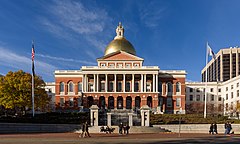
Back محكمة ماساتشوستس العامة Arabic Cort General de Massachusetts Catalan Massachusetts General Court German Corte General de Massachusetts Spanish Cour générale du Massachusetts French Corte Xeral de Massachusetts Galician マサチューセッツ州議会 Japanese Corte Geral de Massachusetts Portuguese Генеральный совет Массачусетса Russian Massachusetts General Court SIMPLE
Massachusetts General Court | |
|---|---|
| 193rd General Court of Massachusetts | |
 Seal of the Commonwealth of Massachusetts | |
| Type | |
| Type | |
| Houses | Senate House of Representatives |
Term limits | None |
| History | |
| Founded | Original charter March 18, 1629 Modern form October 25, 1780 |
| Preceded by | Massachusetts Provincial Congress (1774–1780) |
New session started | January 4, 2023 |
| Leadership | |
| Structure | |
| Seats |
|
 | |
Senate political groups | Majority (36)
Minority (4)
|
 | |
House of Representatives political groups | Majority (135)
Minority (24)
Vacant (1)
|
| Elections | |
Last Senate election | November 8, 2022 |
Last House of Representatives election | November 8, 2022 |
Next Senate election | November 5, 2024 |
Next House of Representatives election | November 5, 2024 |
| Meeting place | |
 | |
| Massachusetts State House Boston | |
| Website | |
| malegislature | |
| Constitution | |
| Constitution of Massachusetts | |
| Rules | |
| Joint Rules of the Massachusetts Senate and House of Representatives | |
The Massachusetts General Court, formally the General Court of Massachusetts,[1] is the state legislature of the Commonwealth of Massachusetts located in the state capital of Boston. The name "General Court" is a holdover from the earliest days of the Massachusetts Bay Colony, when the colonial assembly, in addition to making laws, sat as a judicial court of appeals. Before the adoption of the state constitution in 1780, it was called the Great and General Court, but the official title was shortened by John Adams, author of the state constitution. It is a bicameral body. The upper house is the Massachusetts Senate which is composed of 40 members. The lower body, the Massachusetts House of Representatives, has 160 members; until 1978, the state house had 240 members.[2] It meets in the Massachusetts State House on Beacon Hill in Boston.
Since 1959, Democrats have controlled both houses of the Massachusetts General Court, often by large majorities.[3][4] The Democrats enjoyed veto-proof supermajorities in both chambers for part of the 1990s (i.e., enough votes to override vetoes by a governor)[3] and also currently hold supermajorities in both chambers.[5]
State senators and representatives both serve two-year terms.[6] There are no term limits; a term limit was enacted by initiative in Massachusetts in 1994 but in 1997 was struck down by the Massachusetts Supreme Judicial Court, which ruled that it was an unconstitutional attempt to provide additional qualifications for office by statute, rather than constitutional amendment.[7][8]
The legislature is a full-time legislature, although not to the extent of neighboring New York or some other states.[9]
- ^ Constitution of the Commonwealth of Massachusetts. See Chapter I, Section I, Art.I
- ^ John A. Hird, Power, Knowledge, and Politics: Policy Analysis in the States (Georgetown University Press, 2005), p. 93.
- ^ a b Robert B. Hackey, Rethinking Health Care Policy: The New Politics of State Regulation (Georgetown University Press, 1998), p. 123.
- ^ John Hudak, Presidential Pork: White House Influence over the Distribution of Federal Grants (Brookings Institution Press, 2014), p. 202 ("Democrats frequently control a supermajority of both houses of the state legislature in Massachusetts").
- ^ Jonathan Cohn, Democratic supermajority not so super: Lawmakers from same party but not on same platform, Commonweal (May 27, 2017).
- ^ Constitution of the Commonwealth of Massachusetts, Article LXXXII.
- ^ Jennie Drage Bowser & Gary Moncrief, "Term Limits in State Legislatures" in Institutional Change in American Politics: The Case of Term Limits (eds. Karl T. Kurtz, Bruce E. Cain & Richard G. Niemi) (University of Michigan Press, 2007), p. 11.
- ^ Rimer, Sarah (July 12, 1997). "Top Massachusetts Court Overturns Term Limits". The New York Times. Archived from the original on August 29, 2022. Retrieved July 11, 2023.
- ^ Full- and Part-Time Legislatures, National Conference of State Legislatures (June 14, 2017).